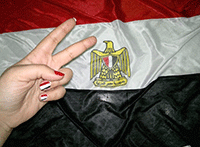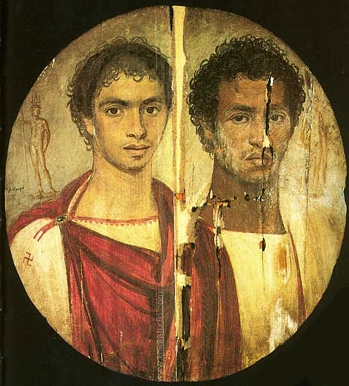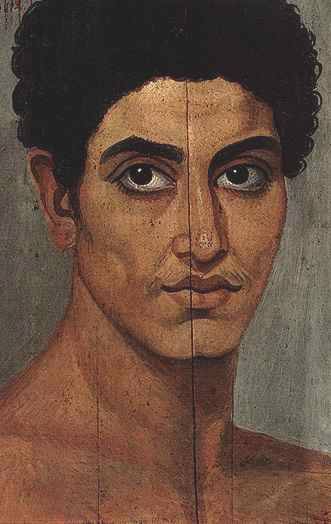0
















| Thumbs Up |
| Received: 119 Given: 25 |

Mummy portraits or Fayum mummy portraits (also Faiyum mummy portraits) is the modern term given to a type of naturalistic painted portraits on wooden boards attached to mummies from the Coptic period. They belong to the tradition of panel painting, one of the most highly regarded forms of art in the Classical world. In fact, the Fayum portraits are the only large body of art from that tradition to have survived.
Mummy portraits have been found across Egypt, but are most common in the Faiyum Basin, particularly from Hawara and Antinoopolis, hence the common name. "Faiyum Portraits" is generally thought of as a stylistic, rather than a geographic, description. While painted Cartonnage mummy cases date back to pharaonic times, the Faiyum mummy portraits were an innovation dating to the Coptic period on time of the Roman occupation of Egypt.
They date to the Roman period, from the late 1st century BCE or the early 1st century CE onwards. It is not clear when their production ended, but recent research suggests the middle of the 3rd century. They are among the largest groups among the very few survivors of the highly prestigious panel painting tradition of the classical world, which was continued into Byzantine and Western traditions in the post-classical world, including the local tradition of Coptic iconography in Egypt.
The portraits covered the faces of bodies that were mummified for burial. Extant examples indicate that they were mounted into the bands of cloth that were used to wrap the bodies. Almost all have now been detached from the mummies. They usually depict a single person, showing the head, or head and upper chest, viewed frontally. In terms of artistic tradition, the images clearly derive more from Graeco-Roman traditions than Egyptian ones.
Two groups of portraits can be distinguished by technique: one of encaustic (wax) paintings, the other in tempera. The former are usually of higher quality.
About 900 mummy portraits are known at present. The majority were found in the necropoleis of Faiyum. Due to the hot dry Egyptian climate, the paintings are frequently very well preserved, often retaining their brilliant colours seemingly unfaded by time.















| Thumbs Up |
| Received: 119 Given: 25 |

Modern Fayum people
Abd El-Munim Riad
Sufi Abu Taleb
Yousef Wali
Zakariyya Ahmad
Sayd Abd el-Hafiez - Football player
Mohamed Abdelwahab
Sabry Raheel
Nagla Fathy - Actress
Ahmed Abd el-Rahman - Politician
















| Thumbs Up |
| Received: 21,121 Given: 11,131 |

They look like modern North Egyptians.














| Thumbs Up |
| Received: 119 Given: 25 |

Random photos of Fayum people















| Thumbs Up |
| Received: 587 Given: 426 |

The depicted persons were likely part of the upper-class. Therefore, it's unlcear to which ethnic group the shown persons actually belong. They could also be Greeks or Romans (at least some of them).
Last edited by Wolf; 06-17-2013 at 10:12 PM.















| Thumbs Up |
| Received: 21,121 Given: 11,131 |

''Under Greco-Roman rule, Egypt hosted several Greek settlements, mostly concentrated in Alexandria, but also in a few other cities, where Greek settlers lived alongside some seven to ten million native Egyptians.[10] Faiyum's earliest Greek inhabitants were soldier-veterans and cleruchs (elite military officials) who were settled by the Ptolemaic kings on reclaimed lands.[11][12] Native Egyptians also came to settle in Faiyum from all over the country, notably the Nile Delta, Upper Egypt, Oxyrhynchus and Memphis, to undertake the labor involved in the land reclamation process, as attested by personal names, local cults and recovered papyri.[13] It is estimated that as much as 30 percent of the population of Faiyum was Greek during the Ptolemaic period, with the rest being native Egyptians.[14] By the Roman period, much of the "Greek" population of Faiyum was made-up of either Hellenized Egyptians or people of mixed Egyptian-Greek origins.[15]
While commonly believed to represent Greek settlers in Egypt,[16][17] the Faiyum portraits instead reflect the complex synthesis of the predominant Egyptian culture and that of the elite Greek minority in the city.[18] According to Walker, the early Ptolemaic Greek colonists married local women and adopted Egyptian religious beliefs, and by Roman times, their descendants were viewed as Egyptians by the Roman rulers, despite their own self-perception of being Greek.[19] The dental morphology[20] of the Roman-period Faiyum mummies was also compared with that of earlier Egyptian populations, and was found to be "much more closely akin" to that of ancient Egyptians than to Greeks or other European populations.''














| Thumbs Up |
| Received: 6,519 Given: 9,857 |

These people look identical to Modern Egyptians. Not a single one looks Greek or could have passed as Greek, except this one (that may be member of Greek minority):
This must be the most common face in modern Egypt, a face one can only find in Egypt:

There are currently 1 users browsing this thread. (0 members and 1 guests)
Bookmarks